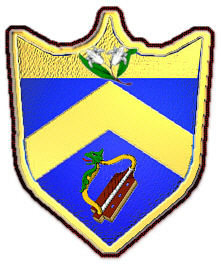The chevron appeared frequently in heraldry, particularly with the British and French. "Chevron" is French for "rafter" and looks like a roof, meant to represent protection (
NHHC). It was awarded to people who had participated in a notable enterprise, had built churches or fortresses, or had accomplished work of faithful service. The chevron was displayed on shields and coats of arms of knights, barons, and kings, and were considered an honor since at least the twelfth century. At first it would reach the top of the shield, but eventually it was reduced to about 1/3 of the space to provide room for images to be displayed more attractively around it.
 |
| French Coat of Arms |
Chevrons continue to signify honor today. The United States armed forces, for example, use them to identify rank (
NHHC). The stripes worn by Air Force members also use chevrons. Even letterman jackets for sports teams use chevrons. A chevronel is a very small version of the chevron and can be stacked on top of each other or laid side by side. This is the form of which chevrons are used now, as opposed to a big one on a shield.
 |
| United States Air Force Airman first Class |
 |
| Letter jacket |









It's amazing how old symbols are still used today. I always thought those lines on military uniforms were just weird arrows!
ReplyDelete